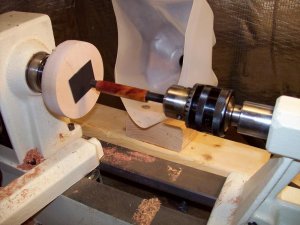flip
Member
As described, I have done several pens with CA and about half of the time it seems like the CA delaminates. My usual routine is sand to 600, wipe down with DNA, wax bushings lightly, 2-3 coats of thin stick fast, 3-4 of medium, wet sand with mm through 12000, plastic polish, assemble.
There are times when I use the skew to separate the tube from the bushing but not always, doesn't seem to matter. Always knock off excess from ends of tubes and sometime will use some thin CA to seal too.
It seems like when the parts bottom out the pressure causes the CA to separate from the tube OR the layers of CA are delaminating. It looks like a half moon on the edge. Sometimes I can put a drip of thin on the area and it will wick in and make it disappear, sometime not.
Cleaned out tubes to eliminate bulge blowout and only used enough pressure to close gap between tube and part being pressed. Ideas?
There are times when I use the skew to separate the tube from the bushing but not always, doesn't seem to matter. Always knock off excess from ends of tubes and sometime will use some thin CA to seal too.
It seems like when the parts bottom out the pressure causes the CA to separate from the tube OR the layers of CA are delaminating. It looks like a half moon on the edge. Sometimes I can put a drip of thin on the area and it will wick in and make it disappear, sometime not.
Cleaned out tubes to eliminate bulge blowout and only used enough pressure to close gap between tube and part being pressed. Ideas?

